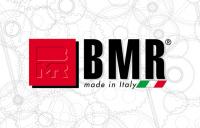Dry super-polishing porcelain tile treatments

With its SuperShine technology, BMR innovates the stage subsequent to ceramic tile lapping
BMR has developed SuperShine technology, a treatment performed by a very similar machine to the one used for lapping but heavier and equipped with dry technology. SuperShine can be defined as the first true dry super-polishing machine.
SuperShine is a hi-tech machine that carries out a thermomechanical process capable of increasing the gloss level following lapping by 20 points or more.
It uses 7 satellite heads of diameter 580 mm, each equipped with 6 tools of diameter 160 mm. The heads are driven by 15 kW motors which bring a significant increase in productivity and allow for belt speeds of 10 m/minute or more. The heads apply a micro-abrasive product and natural silica in a fluid suspension in a quantity programmed and dosed from the machine’s control panel, using their force and weight to press the product onto the surface.
During the super-polishing phase, the fluid and micro-abrasive are brushed under pressure over the surface of the tile or slab. The pressure ensures a high degree of penetration inside the pores and microgrooves, while their crests are worn down by the brushing process. The surfaces are subsequently washed by a further 3 heads positioned at the exit, which perform a super-polishing action deep inside the microgrooves and guarantee consistent finished product quality.
The super-polishing operation performed by SuperShine makes the ceramic surface more resistant to soiling and staining, while the honing process creates a uniform surface. There is a close relationship between the gloss levels attained and the roughness of the material (Ra), represented by the average value between peaks and troughs of the microgrooves. Although the roughness is difficult to feel when touched, its value is important for the purposes of the treatments and consequently for the quality of the finished product.
Generally, a lapped product arrives at the super-polishing stage with a gloss level of 55-60 Gloss and average roughness of Ra 0.060 mm and leaves the treatment with 95-100 Gloss and Ra 0.020 mm. With this final roughness value the tile has a good level of resistance to soiling and staining. If the final value of Ra remains at 0.060 mm, this means that the treated product had an excessively high degree of roughness which may reduce the effectiveness of the treatment.
So clearly the lapped surface has deep pores and microgrooves that may impair the cleanability of the surface. The mechanical action of super-polishing brings a clear improvement because it reduces the height of the ridges and thereby facilitates the pore filling process, contributing to the tile’s high value of dirt resistance.
Considering the technical and technological characteristics of this process, BMR envisages the technological process of lapping as a combination of the wet lapping and dry super-polishing operations performed by combining LevigaPlus and SuperShine. This is a big advantage for users because the surface treatment process can be performed by a single, complete and highly flexible machine equipped with functions, accessories and mechatronic elements that enable it to comply with standards while adapting the working cycles according to requirements.
This way, the polishing process can easily be adapted to any type of ceramic surface directly by the operator.
Did you find this article useful?
Join the CWW community to receive the most important news from the global ceramic industry every two weeks





















